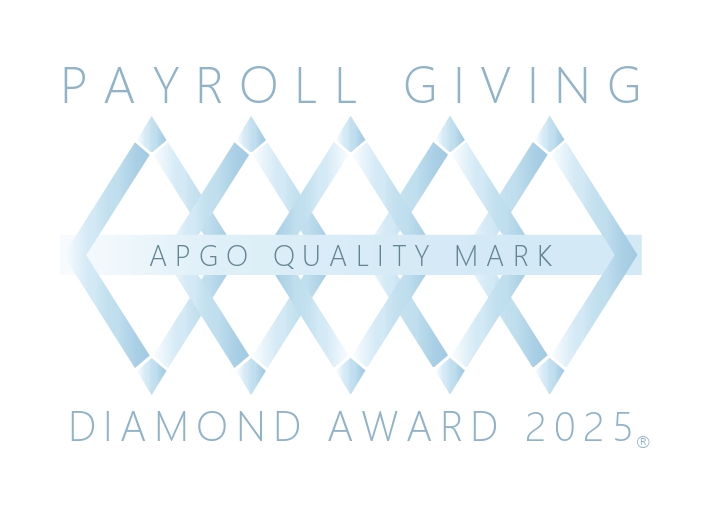After filling in the form, we'll give you a whistle stop tour of our platform, showing you how easy Payroll Giving is to get set up.
 Payroll Giving Explained: A Guide For Employers. Download your free copy >>
Payroll Giving Explained: A Guide For Employers. Download your free copy >>

10 Sustainable Workplace Practices You Can Implement Today
Alice Wright, GoodPAYE
Building an environmentally sustainable workplace isn’t just good PR, it’s an expectation of your employees and customers. From cutting energy waste to greener commuting and clever procurement, organisations are embracing sustainable workplace practices to match those rising expectations (and yes, to sleep better at night).
But going green doesn’t mean turning your office into a wind farm by Friday.
Real change comes from weaving sustainable workplace practices into the everyday stuff – from the boardroom to the break room. In this guide, you’ll find practical ideas to boost environmental sustainability in your workplace that are easy to action and genuinely effective.
So, whether you’re after some actionable examples of comprehensive sustainability in the workplace or just want to dip your toe in the water of building a more environmentally friendly workplace, you’re in the right place.
Let’s dive into how being green at work can be surprisingly simple.
In this article, we cover:
- Launch a green workplace team
- Boost efficiency with energy-smart tech
- Go paperless and cut digital pollution
- Support Environmental Charities Through Payroll Giving
- Ensure sustainable procurement
- Embed recycling & waste-reduction systems
- Promote greener commuting and remote work
- Bring nature inside
- Monitor, report, certify
- Educate, encourage and recognise
First, define your workplace sustainability goals
Every great journey needs a starting point, and when it comes to creating a sustainable workplace, that means knowing where you currently stand.
First you’ll need to assess your organisation’s environmental footprint.
Look at the usual suspects:
- Energy consumption
- Water usage
- Waste output
- Travel habits
You might be surprised by what’s draining your resources (it’s often those forgotten office printers churning out full-colour pages no one ever reads).
Once you have a clear picture of where you stand, set some realistic, measurable targets to steer your environmentally friendly workplace ambitions. Think “reduce office energy use by 10% in 12 months” or “cut single-use plastic by 80% by the end of the year.”
These kinds of tangible goals make it easier to track progress and keep everyone on the same (recycled) page.
Importantly, make sure your goals are visible, actionable, and achievable.
No one’s expecting you to turn the office into a zero-waste permaculture farm overnight. So start with what’s doable, build from there. And celebrate progress along the way. As every small win brings you closer to a truly environmentally sustainable workplace.
Help your employees donate more to environmental charities through Payroll Giving
Download your free guide guide here
Everything employers need to know about running a payroll donation scheme.
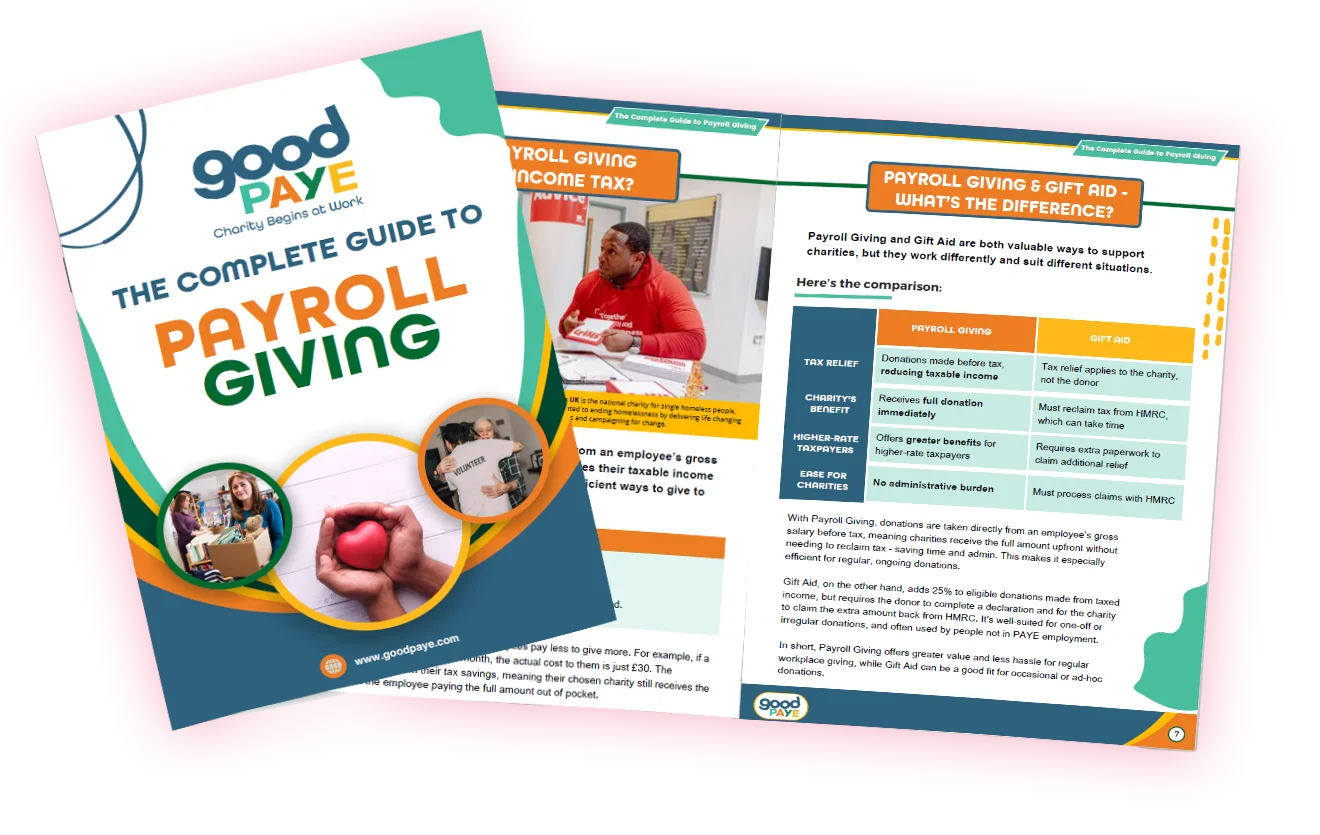
Our Top 10 Sustainable Workplace Practices
Whether it’s cutting back on business travel or switching to a green energy supplier, there are plenty of ways to show you’re serious about being green in the workplace.
Need some inspiration? Here are our top ideas…
1. Launch a green workplace team
No one builds a sustainable workplace alone. It takes a group with a shared vision.
Enter your green dream team of eco-minded employees ready to lead the charge on sustainable workplace practices.
Bring together people who care, have ideas and can rally others behind a shared mission. Start by inviting volunteers from across departments – HR, facilities, finance, that one person who’s always turning off lights in empty meeting rooms, etc. You’ll want a mix of perspectives to ensure your sustainability efforts are well-rounded and relevant to every part of the business.
Once your team is in place, give them a clear remit and the freedom to make things happen.
This could include everything from reviewing supplier policies to suggesting new recycling systems, organising tree-planting days or even hosting “green challenges”.
Regular meetings, a shared action plan and visible support from leadership will help the team stay on track.
And don’t forget to celebrate their wins – public praise, internal shout-outs, or even a cheeky eco-friendly reward can go a long way. After all, when your colleagues feel involved and empowered, change becomes a lot more meaningful (and a lot more likely to stick).
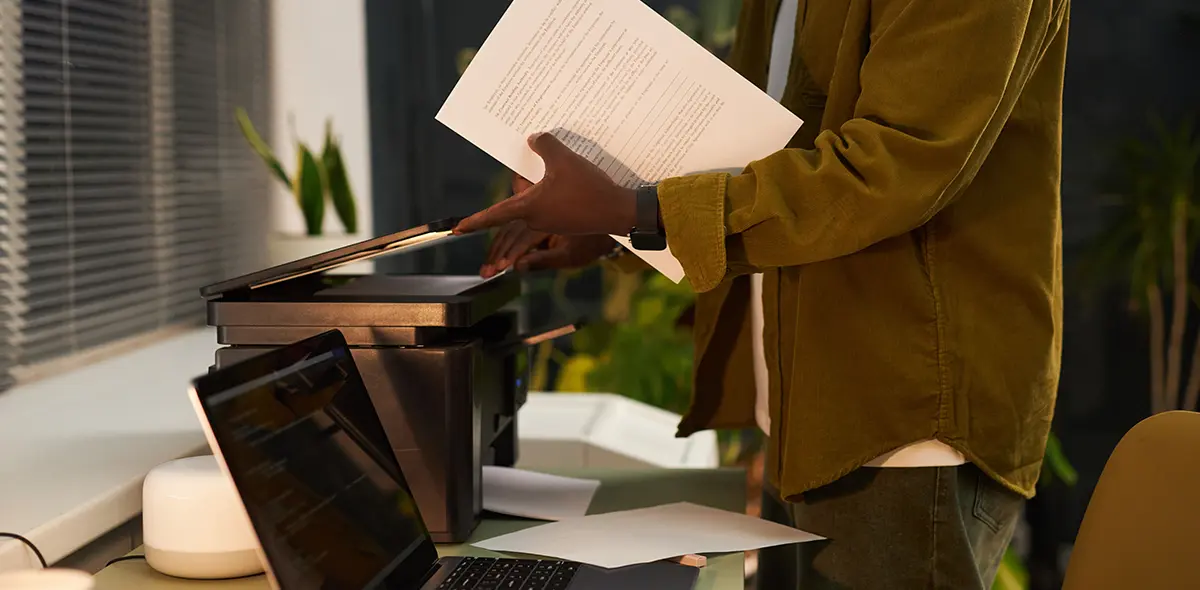
2. Boost efficiency with energy-smart tech
If your office still relies on flickering fluorescent tubes and ancient desktop PCs that sound like jet engines on take-off, it might be time for a tech upgrade.
Embracing smarter, greener technology is one of the easiest ways to create a more sustainable workplace.
Start with the basics
Swap out traditional bulbs for energy-efficient LEDs (bonus points if they’re motion-sensor activated). Add smart thermostats to avoid heating the office like a sauna in December and use timers or occupancy sensors to power down devices when no one’s around. Small changes like these can drastically reduce your environmental impact (and your energy bills).
Look at your equipment
Encourage staff to shut down computers at the end of the day (yes, sleep mode still uses energy) and invest in laptops over desktops, as they use up to 80% less power. Cloud-based storage platforms and digital collaboration tools also cut down on unnecessary travel, printing and energy consumption.
For offices with shared workspaces or hybrid teams, consider desk booking systems and occupancy sensors to manage resources more efficiently.
Fewer desks in use? Lower the lighting, reduce HVAC use and save energy without lifting a finger. It’s these clever, low-effort tweaks that make a big difference when building an environmentally friendly workplace.
Server rooms, printers and kitchen appliances
Check for energy ratings, and upgrade when you can. That office fridge from 2004 might be quietly guzzling more power than the rest of your tech combined.
Ultimately, environmental sustainability isn’t about having the flashiest gear, but it is about using technology smarter. Whether you’re a startup or a legacy business, there are always ways to reduce your footprint, lower costs and make your workplace greener.
So if your IT department’s been itching for an upgrade, here’s your eco-friendly excuse.
You’re not just modernising, you’re making meaningful strides toward a truly green workplace.

3. Go paperless and cut digital pollution
Ah, paper. Crisp, satisfying and oddly comforting… but in a truly sustainable workplace, it should be more of a special guest than a permanent resident.
Reducing paper use is one of the most straightforward ways to support environmental sustainability in the workplace and with digital tools aplenty, there’s really no excuse for printing every single email “just in case.”
Start by switching to digital workflows wherever possible. Invoices, contracts, meeting notes, onboarding packs – it can all be done online. Platforms like DocuSign, Google Workspace, or project management tools can help your team collaborate without creating a forest’s worth of paperwork.nsparency, more ethical practices and surprisingly competitive prices.
Still need to print occasionally? Then set defaults to double-sided and black-and-white.
But don’t stop there. A truly environmentally friendly workplace also tackles digital waste. The endless stream of unread emails, duplicate files, and never-used cloud backups might not seem like a big deal, but they all use energy. (That 2018 presentation no one’s opened since the Christmas party? Still sitting on a server somewhere, quietly contributing to your carbon footprint.)
Encourage regular digital spring-cleaning. Delete old files, unsubscribe from newsletters no one reads and archive with intention. Bonus points if your website is hosted on a green server!
If you’re serious about sustainability at the workplace, don’t just bin the paper – bin the mindset that says printing is the only way to be “official.”

4. Support Environmental Charities Through Payroll Giving
One of the simplest and often overlooked ways to make a difference is by enabling employees to donate to environmental charities – pre tax – through Payroll Giving.
It’s tax-efficient, meaning employee donations go further, and free for employers.
It provides vital, regular support to organisations tackling climate change and environmental issues. Here at GoodPAYE, we work with fantastic charities like Trees for Cities, Greenpeace, and FareShare, to make it easy for employees to support causes that matter.
Whether it’s planting trees, fighting plastic pollution or reducing food waste, Payroll Giving allows employees to give back directly from their salary – effortlessly and impactfully.
Watch on demand:
Payroll Giving Webinar
In this short webinar, we cover:
The impact Payroll Giving has
How employers can make a difference
What you can do to drive social change
5. Ensure sustainable procurement
Creating a truly sustainable workplace doesn’t stop at what you do internally – it also depends on who you do business with. Sustainable procurement means making conscious choices about where your supplies, equipment and services come from, and how they align with your values around environmental sustainability in the workplace.
Start by reviewing your current suppliers. Are your office materials made from recycled or responsibly sourced materials? Is your coffee Fairtrade, your printer paper FSC-certified, your cleaning products eco-friendly and cruelty-free? After all, your procurement habits speak volumes about your priorities… and your carbon footprint.
Switching to greener suppliers often brings better transparency, more ethical practices and surprisingly competitive prices.
You don’t need to overhaul everything at once, but changes add up, and they send a strong message to your team and your customers that you’re building an environmentally friendly workplace from the inside out.
When it comes to office fit-outs, prioritise energy ratings, durability and repairability. Investing in longer-lasting kit might cost more upfront, but it’ll save money (and resources) down the line.
You can also work with suppliers to improve their own sustainability efforts.
Ask questions, request sustainability statements and consider including environmental performance in your procurement criteria. You’re not just a customer – you’re part of a chain of influence that can help drive better standards across your industry.
And if you want to get a little fancier, you could introduce a procurement policy or supplier code of conduct that outlines your expectations around sustainability in the workplace.
If you want to create a truly green workplace, the journey starts with choosing partners who walk the talk.
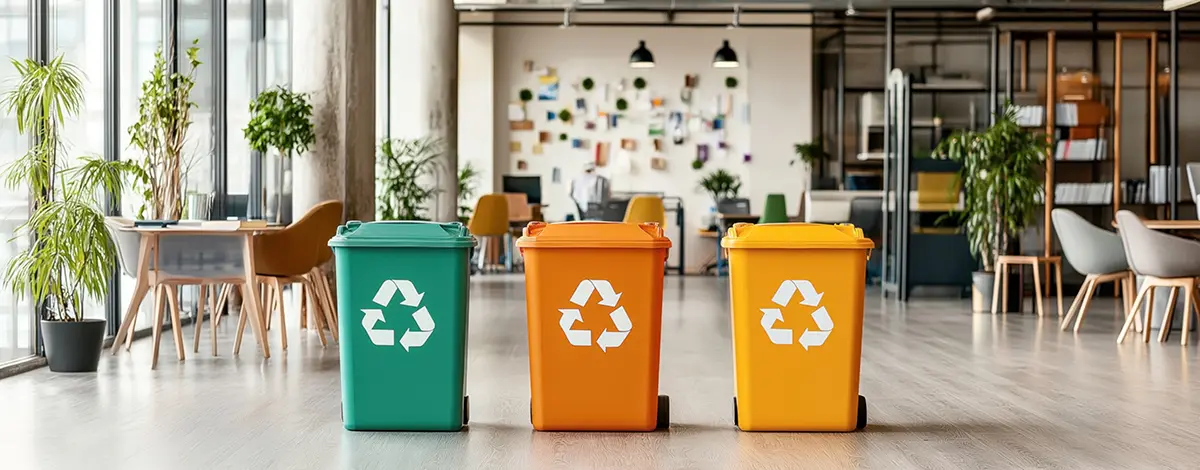
6. Embed recycling & waste-reduction systems
If your workplace has one lonely recycling bin hidden behind a filing cabinet and no one’s quite sure what goes in it, it might be time for a rethink.
Embedding proper recycling and waste-reduction systems is one of the clearest, most visible ways to support environmental sustainability in the workplace. Yet it’s all too often delivered poorly.
Start with the basics
Make recycling easy, obvious and accessible. That means clearly labelled bins for paper, plastics, cans, food waste and general rubbish. Use signage with actual pictures if needed, because no one’s going to read a three-paragraph explanation of what “mixed dry recyclables” means on a Monday morning.
Look at where you can reduce waste
Ditch single-use plastics in the kitchen and meeting rooms – reusable mugs, cutlery and glasses go a long way towards creating a more environmentally friendly workplace.
In shared areas, stock up on refill stations for things like hand soap, washing-up liquid and cleaning products.
Composting is a great option for food waste if your building allows for it. If not, partner with a food waste collection service or local initiative. Got extra catering after a meeting? Set up a staff share table or donate to local charities where possible.
Run a waste audit (not as scary as it sounds) to see where you can improve. It might reveal surprising trends.

7. Promote greener commuting and remote work
Encouraging greener commuting habits and flexible work options is a fantastic initiative that benefits both sustainable working but also employee wellbeing.
Make it easy for people to choose low-impact travel. Set up a cycle-to-work scheme (or remind your team it exists!), provide secure bike storage, and if you’ve got the space, somewhere to shower and change post-commute wouldn’t go amiss.
Public transport more your team’s thing? Offer season ticket loans or discounts. And for those who must drive, consider setting up a carpool group or allocating priority parking for lift-sharers.
If travel is necessary, consider carbon offsetting initiatives.
Remote and hybrid working, of course, also plays a major role in environmental sustainability. Fewer people commuting means fewer emissions – not to mention happier, more productive employees who don’t have to sprint for the 7:02 every morning. So encourage virtual meetings over travel wherever possible, and equip your team with the tools they need to work from home efficiently. That’s laptops, cloud access, video calls – and ideally a culture of trust, too.
Even if your business needs people on-site regularly, offering a bit of flexibility can still go a long way. Compressed hours, staggered start times and “work from home Wednesdays” are all practical ways to support sustainability and wellbeing without sacrificing structure.
After all, a green workplace isn’t just about what happens inside the building, it’s about how your people get there, and how often they really need to be there at all.
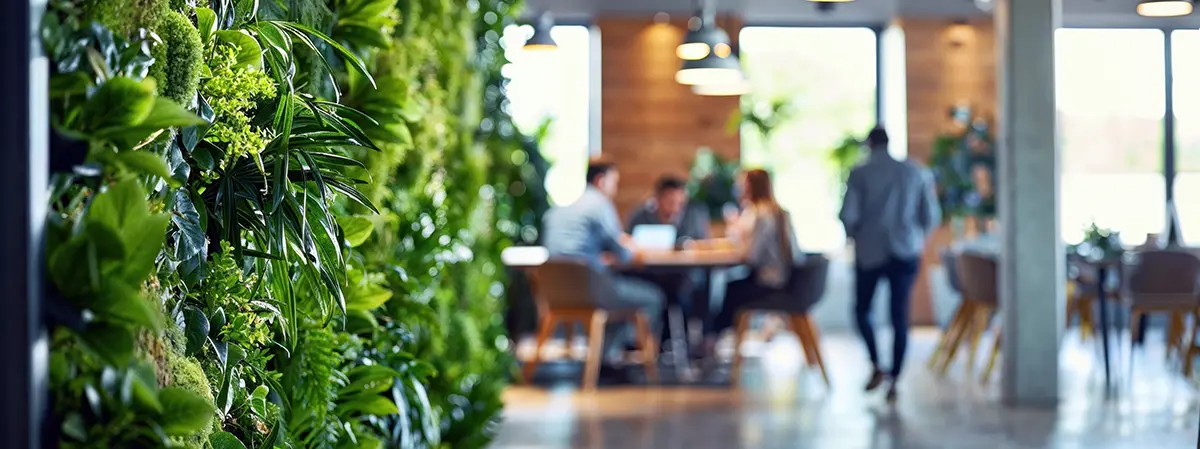
8. Bring nature inside
You don’t need to turn your office into Kew Gardens to feel the benefits of greenery, but a few well-placed plants can do wonders for your team and your sustainability goals.
Incorporating nature into your workspace is a simple, often-overlooked step, with big returns for wellbeing, air quality and overall office vibes.
Add leafy plants, hang greenery in breakout spaces, or even build a living wall if you’re feeling ambitious (and want to impress visitors). Plants help purify the air, reduce stress, and even boost productivity.
If you’ve got outdoor space, create a green area for lunch breaks or meetings. Even a few benches surrounded by plants can encourage people to get some fresh air, connect with nature, and step away from the screen for five minutes.
And don’t stop at foliage. Use natural light wherever possible (it’s free, after all), swap out harsh overheads for softer, more energy-efficient alternatives and choose natural materials for office furniture and finishes (eg wood, bamboo, recycled textiles). These elements create a calmer, more inviting environment and support your broader sustainable workplace practices.
Your team will love it as people genuinely feel better when they’re surrounded by a bit of green.

9. Monitor, report, certify
Start by monitoring your key sustainability metrics: energy usage, waste output, water consumption, business travel, and any other emissions you’re able to measure. You don’t need to be a data scientist, as many energy providers offer usage breakdowns, and there are plenty of affordable tools to help you track your impact.
Once you’ve got the data, use it.
Create internal reports to keep staff informed and share key highlights in comms to showcase your commitment. It’s not about greenwashing – it’s about transparency, accountability and showing that your efforts are more than just surface-level.n brings better transparency, more ethical practices and surprisingly competitive prices.
When you’re ready to take things up a notch, consider working towards recognised sustainability certifications. ISO 14001 is a popular standard for environmental management, while B Corp status provides a broader framework for balancing people, planet and profit. LEED or WELL certifications may also be relevant if you’re upgrading or redesigning your office with sustainable workplace practices in mind.
Certifications not only validate your efforts, they also boost your reputation, build trust with customers and partners, and often improve your chances when bidding for contracts.

10. Educate, encourage and recognise
You can install all the smart tech, bins and bamboo desks you like, but if your team isn’t on board, your journey to a sustainable workplace will stall faster than an electric scooter with a flat battery.
That’s why education, encouragement and a bit of recognition are just as important as policies and infrastructure.
Start by raising awareness.
Most people want to do the right thing, they just don’t always know how.
Clear signage, induction sessions for new starters and quick “green tips” in internal newsletters can all help embed sustainable workplace practices into everyday habits. Keep the language simple, visual and jargon-free.
Then, make it engaging.
Host themed weeks (think Plastic-Free July, Meat-Free Mondays), run team challenges, or invite guest speakers to talk about sustainability at the workplace and beyond. You don’t need to become a full-blown eco-evangelist, just show that sustainability can be fun, meaningful and relevant to your team’s daily lives.
Recognition goes a long way, too.
Celebrate eco-champions who go above and beyond – perhaps there’s someone who’s reduced their commuting emissions, started a mini office herb garden or helped implement a new recycling system.
A bit of appreciation encourages others to get involved and builds a sense of shared ownership.
And remember: lead by example.
If leadership is visibly invested, employees are far more likely to follow suit.
Whether it’s the CEO cycling to work or managers championing green initiatives in meetings, action speaks louder than that dusty “Think before you print” poster in the break room.
At the end of the day, culture is key. Sustainability thrives in organisations where it’s not just a policy, it’s a mindset. And with a little education, a lot of encouragement, and the occasional high-five for good behaviour, your workplace can go from green-curious to green-committed in no time.
Help your employees donate to environmental charities through Payroll Giving
Download your free guide guide here
Everything employers need to know about running a payroll donation scheme.




